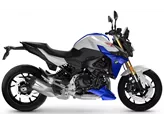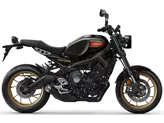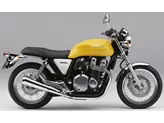Yamaha XSR900 2016 vs. Kawasaki Z900 2017

Yamaha XSR900 2016

Kawasaki Z900 2017
Visão geral - Yamaha XSR900 2016 vs Kawasaki Z900 2017
The Yamaha XSR900 2016 and the Kawasaki Z900 2017 are both naked bikes that offer powerful performance and modern design.
In terms of the engine and drivetrain, the Yamaha XSR900 2016 features an inline 3-cylinder engine with a displacement of 847cc, producing 115 horsepower and 87.5 Nm of torque. On the other hand, the Kawasaki Z900 2017 is equipped with an inline 4-cylinder engine with a displacement of 948cc, delivering 125.4 horsepower and 98.6 Nm of torque. Both bikes have liquid cooling systems, ensuring efficient temperature management.
When it comes to suspension, both bikes have upside-down telescopic forks at the front and a swingarm with a monoshock at the rear. This setup provides a balanced and comfortable ride, absorbing bumps and ensuring stability.
In terms of chassis, the Yamaha XSR900 2016 features an aluminum frame with a double-tube design, while the Kawasaki Z900 2017 has a steel frame with a double-cradle design. Both frames provide rigidity and stability, contributing to the bikes' overall performance.

Yamaha XSR900 2016
Both bikes are equipped with advanced braking systems, featuring dual disc brakes at the front with a diameter of 298mm for the Yamaha XSR900 2016 and 300mm for the Kawasaki Z900 2017. This ensures reliable stopping power and enhances safety.
Both bikes also come with ABS (anti-lock braking system), providing additional safety and preventing wheel lock-up during sudden braking.
In terms of dimensions, the Yamaha XSR900 2016 has a width of 120mm for the front tire and 180mm for the rear tire, with a wheel diameter of 17 inches for both. It has a wheelbase of 1440mm and a seat height of 815mm. The bike weighs 191kg (with ABS).
On the other hand, the Kawasaki Z900 2017 has the same tire dimensions and wheel diameter as the Yamaha XSR900 2016. It has a slightly longer wheelbase of 1450mm and a lower seat height of 795mm. The bike weighs 210kg (with ABS), making it slightly heavier than the Yamaha XSR900 2016.
In terms of strengths, the Yamaha XSR900 2016 is praised for its powerful engine, well-tuned riding modes, standard ABS and TC, modern and authentic design, and clean finish.

Kawasaki Z900 2017
On the other hand, the Kawasaki Z900 2017 is praised for its ingenious naked bike chassis, magnificent appearance, responsive and powerful engine with perfectly sized torque, and excellent balance between performance, price, and practical use.
In terms of weaknesses, the Yamaha XSR900 2016 is criticized for its rigid chassis, uncomfortable seat, and the fact that the speedometer design is not unique to this model.
Similarly, the Kawasaki Z900 2017 is criticized for having a narrow knee angle for tall riders, suggesting the need to order a different seat for improved comfort.
In conclusion, both the Yamaha XSR900 2016 and the Kawasaki Z900 2017 offer powerful performance, advanced features, and attractive designs. The choice between the two would depend on personal preferences, such as riding style, comfort, and aesthetic appeal.
Especificações técnicas Yamaha XSR900 2016 em comparação com Kawasaki Z900 2017
Prós e contras em comparação
Prós e contras em comparação
Yamaha XSR900 2016

A XSR900 combina o desempenho de uma streetfighter desportiva com o visual de uma naked retro agradável e com acabamentos limpos. Ao fazê-lo, os japoneses fazem uso da sua própria história, que pode ser encontrada em conjunto e sem lacunas no arquivo da agência de design que trabalha para a Yamaha há 60 anos. Adopta as virtudes da MT-09 e corrigiu algumas das suas fraquezas. A sua condução é mais harmoniosa, mais controlada e, se desejado, mais descontraída. Apenas o conforto, e portanto o piloto, sofre com o chassis apertado em estradas más. É preciso ser um pouco sensível quando se trata de uma neo-clássica.
Kawasaki Z900 2017

Uma mota incrivelmente bem concebida. Foi objeto de muitos testes e de muita atenção aos pormenores. Tem exatamente a potência certa, o chassis certo e o visual certo. Uma moto naked de sucesso geral que o fará feliz durante muito tempo. Se quiseres, podes conduzi-la de forma simples e fiel, mas se quiseres, também podes conduzi-la muito depressa e ela roda como o diabo. É óptima!
Comparação de preços Preço médio de mercado Yamaha XSR900 vs Kawasaki Z900
There are a few key differences between a Yamaha XSR900 2016 and a Kawasaki Z900 2017. In terms of price, the actual average price of a Kawasaki Z900 2017 is about 32% higher. A Yamaha XSR900 2016 experiences a loss of 2 050 EUR in one year and 2 070 EUR in two years of ownership. This is offset by a loss of 650 EUR and 1 140 EUR for a Kawasaki Z900 2017. Compared to Kawasaki Z900 2017 there are less Yamaha XSR900 2016 bikes available on the 1000PS.de Marketplace, specifically 5 compared to 43. It takes less time to sell a Yamaha XSR900 with 77 days compared to 85 days for a Kawasaki Z900. Since model year 2016 1000PS.de editors have written 30 reviews for the Yamaha XSR900 and 46 reviews for the Kawasaki Z900 since model year 2017. The first review for the Yamaha XSR900 was published on 25/11/2015 and now has more than 17 600 views. This compares to more than 93 200 views for the first review on Kawasaki Z900 published on 11/11/2016.
















